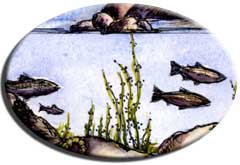What makes fish healthy?
 The health of a stream
has a direct impact on the health of fish that live there. Some species of fish spend their whole lives in streams, while others pass through as
they travel upstream to spawn. Healthy streams support both diverse and abundant fish populations. Fish need different things at different
stages of their lifecycles, e.g., pools for shelter, healthy riparian
vegetation providing shade and cover, sufficient food, and gravels for spawning. Healthy streams provide the variety of characteristics
needed to support fish throughout their lifecycles.
The health of a stream
has a direct impact on the health of fish that live there. Some species of fish spend their whole lives in streams, while others pass through as
they travel upstream to spawn. Healthy streams support both diverse and abundant fish populations. Fish need different things at different
stages of their lifecycles, e.g., pools for shelter, healthy riparian
vegetation providing shade and cover, sufficient food, and gravels for spawning. Healthy streams provide the variety of characteristics
needed to support fish throughout their lifecycles.
Contaminants also impact the health of fish and other animals that eat the fish. Mercury, pesticides, and other chemicals of concern in water and sediment concentrate, or “bioaccumulate,” in the bodies of organisms that fish eat and in the fish themselves. Fish higher on the food chain can develop higher levels of these contaminants. This can have a direct effect on human health, because when we eat the fish, we can also consume the chemicals they contain, causing a host of health problems. Concentrations of pollutants in fish collected from many California water bodies are high enough to cause concern for possible effects on human health.
How do we measure the health of fish?
Through careful monitoring of contaminants in fish, managers can help ensure that fish with higher levels of mercury and other contaminants are not consumed as often by people. Contaminant levels in fish tissue are also used as an indicator of fish health. We do not have fish bioassessment data prepared for release at this time.
- Risk of Fish Tissue Contaminants on Human Health -presented in the portal, "Is it Safe to Eat Fish and Shellfish from our Waters?"

